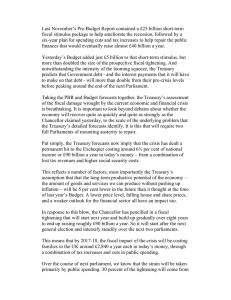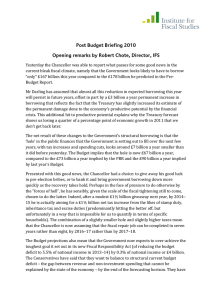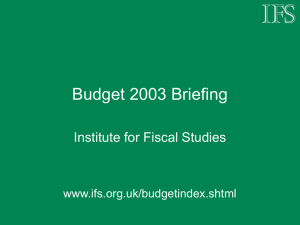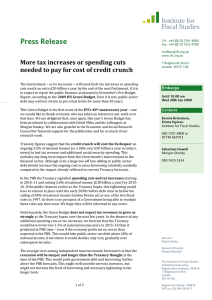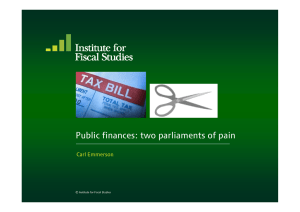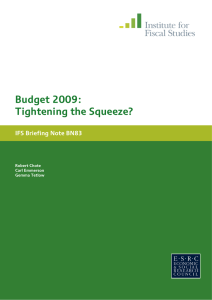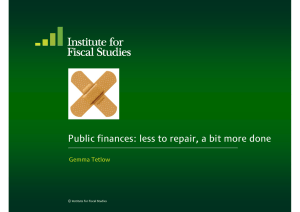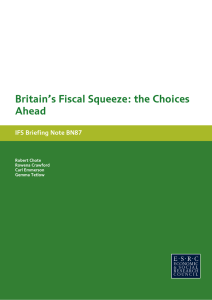Briefing on Pre-Budget Report 2009
advertisement
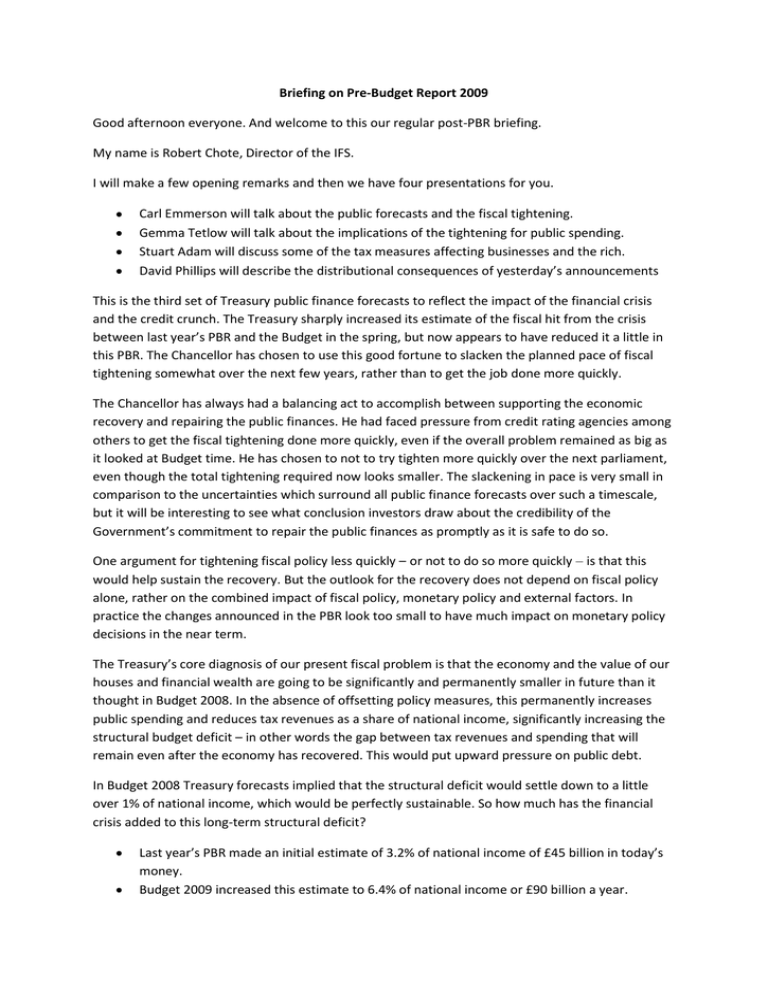
Briefing on Pre-Budget Report 2009 Good afternoon everyone. And welcome to this our regular post-PBR briefing. My name is Robert Chote, Director of the IFS. I will make a few opening remarks and then we have four presentations for you. Carl Emmerson will talk about the public forecasts and the fiscal tightening. Gemma Tetlow will talk about the implications of the tightening for public spending. Stuart Adam will discuss some of the tax measures affecting businesses and the rich. David Phillips will describe the distributional consequences of yesterday’s announcements This is the third set of Treasury public finance forecasts to reflect the impact of the financial crisis and the credit crunch. The Treasury sharply increased its estimate of the fiscal hit from the crisis between last year’s PBR and the Budget in the spring, but now appears to have reduced it a little in this PBR. The Chancellor has chosen to use this good fortune to slacken the planned pace of fiscal tightening somewhat over the next few years, rather than to get the job done more quickly. The Chancellor has always had a balancing act to accomplish between supporting the economic recovery and repairing the public finances. He had faced pressure from credit rating agencies among others to get the fiscal tightening done more quickly, even if the overall problem remained as big as it looked at Budget time. He has chosen to not to try tighten more quickly over the next parliament, even though the total tightening required now looks smaller. The slackening in pace is very small in comparison to the uncertainties which surround all public finance forecasts over such a timescale, but it will be interesting to see what conclusion investors draw about the credibility of the Government’s commitment to repair the public finances as promptly as it is safe to do so. One argument for tightening fiscal policy less quickly – or not to do so more quickly – is that this would help sustain the recovery. But the outlook for the recovery does not depend on fiscal policy alone, rather on the combined impact of fiscal policy, monetary policy and external factors. In practice the changes announced in the PBR look too small to have much impact on monetary policy decisions in the near term. The Treasury’s core diagnosis of our present fiscal problem is that the economy and the value of our houses and financial wealth are going to be significantly and permanently smaller in future than it thought in Budget 2008. In the absence of offsetting policy measures, this permanently increases public spending and reduces tax revenues as a share of national income, significantly increasing the structural budget deficit – in other words the gap between tax revenues and spending that will remain even after the economy has recovered. This would put upward pressure on public debt. In Budget 2008 Treasury forecasts implied that the structural deficit would settle down to a little over 1% of national income, which would be perfectly sustainable. So how much has the financial crisis added to this long-term structural deficit? Last year’s PBR made an initial estimate of 3.2% of national income of £45 billion in today’s money. Budget 2009 increased this estimate to 6.4% of national income or £90 billion a year. Yesterday’s PBR reduced it to 5.2% of national income or around £73bn a year. The sum total of the tax and spending announcements in PBR 2008, Budget 2009 and PBR 2009 is to slightly more than close this newly opened gap by 2017–18. Government debt is predicted to peak slightly higher and slightly later than the Treasury expected in the Budget, partly because of the slower tightening pace over the next Parliament. But the continuation of the tightening beyond the next Parliament means that debt is on course to return to pre-crisis levels slightly more quickly than in the Budget. However, figures in the Treasury’s Long Term Public Finance Report underline the fact that we would need to pay more for the costs of an ageing population – as well as the costs of the crisis – to keep debt returning to pre-crisis levels. The PBR also gave us some information about the outlook for public spending over the Treasury’s next three year spending review. It looks as though Whitehall spending on public services and administration is set to fall by around 3.2% a year in real terms over the three years beginning in 2011–12. This is slightly larger than the 2.9% decline the Treasury calculated at the time of the last Budget and which was subsequently leaked. But this largely reflects higher spending on the costs of the war in Afghanistan in the base year for this comparison. Once we take into account the announcements of real spending growth on the frontline NHS, schools and Sure Start for 2011–12 and 2012–13, other departmental budgets are likely to need to shrink by 5.6% a year on average over the three years of the spending review – a little under 16% in total. (This assumes that the Chancellor does not decide to continue protecting his priority areas for a third year, in which case the squeeze would be even tighter at around 6.9% a year). The bottom line is that the targeted spending on priority areas is paying paid for not just by higher taxes, but by a severe squeeze elsewhere in the public services.
